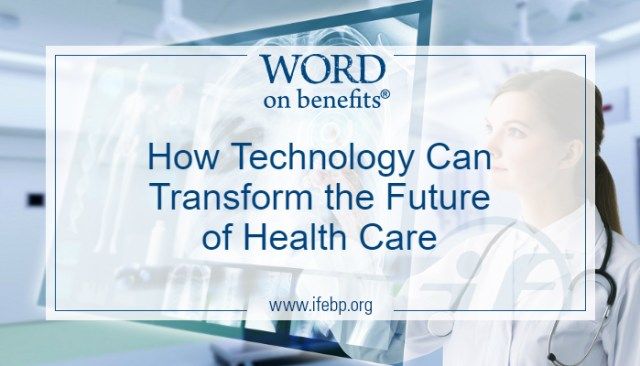
“Information is growing faster than we can handle and analyze efficiently, and medical data is expected to double every 73 days by 2020,” says Nathalie Le Prohon, vice president, health care industry for IBM Canada in Montreal, Quebec. But developments in technology can also help to harness that data and improve the health care system for clinicians, patients and plans.
Le Prohon presented “Transforming Health Care for the Next Generation” at the 2018 Canadian Health and Wellness Innovations Conference and talked about the transformative power of health care technology for a Q&A in the July/August 2018 issue of Plans & Trusts magazine. The following insights into artificial intelligence (AI), mobile devices and the cloud, predictive health care and waste reduction are just some of the highlights from her conversation.

Artificial Intelligence
In the health care industry, AI is really just beginning to show its promise. Le Prohon lists three ways AI can help to deliver better health outcomes.
- AI solutions can give health care professionals enhanced tools and information to perform their roles with even higher quality. Increased options and data on efficacy can help clinicians decide on better courses of treatment for their patients.
- For patients, AI technology can deliver wellness apps and tools to help them proactively manage their health and become better health care consumers.
- From a systemic standpoint, aging populations and escalating constraints on health care resources are not sustainable. AI solutions can significantly reduce overall costs by identifying and addressing patient outcomes at much earlier stages, improving and expediting diagnoses, and advancing disease identification and prevention.
Register Now: Creating Psychologically Safe and Healthy Workplaces in the United States and Canada | October, 10, 2018 | Free Member Webcast
Mobile Devices and the Cloud
Patient stays in hospitals and care facilities are a major cause of rising health care costs. These expenses are necessary for intensive care but could be reduced for patients who could be monitored in their homes or less-expensive care settings.
“This is where Internet of Things (IoT) devices using cloud technology can extend health care to the home, giving patients freedom and control over their medical care while empowering medical professionals with high-quality data to provide better care,” Le Prohon says. “The adoption of IoT devices in the home with connected access to clinicians can dramatically improve and disrupt the health care ecosystem.”
Examples of recent innovations include bedsheets that can gather and interpret data on heart rate, respiration rate and respiration quality, essentially serving as a patient-monitoring system. Also, there are mobile apps that can help diabetes patients predict and manage potential hypoglycemic events. This can have a huge influence on patient care, as Le Prohon points to studies indicating that a diabetic’s life can be extended by up to eight years through better health management.
Predictive Health Care
Tremendous health care savings can be found through prevention rather than reaction. New technologies can help the industry be proactive in terms of disease outbreaks and emergency room (ER) intakes, Le Prohon notes. A Canadian company is focused on reducing the impact of infectious disease through better diagnoses and detecting pandemics before they happen. “They have developed pathogenomic sequencing that can give doctors the potential to diagnose illnesses at a much faster rate,” she says. “This is, in fact, precision medicine specifically for infectious diseases.”
And a hospital in Toronto, Ontario uses advanced data analytics and reporting to help with ER surges that can overburden resources and staff. “Information includes health outbreaks in the downtown area, city events and changing weather patterns to help predict surges in ER visits so the hospital can better deliver emergency treatments,” Le Prohon notes.
Related Reading: 15 Technology Trends to Enhance Your Wellness Program
Waste Reduction
Le Prohon believes that leading-edge AI and cloud technologies can drive down health care costs by more effectively tackling costly tests, readmissions into the ER and long stays in acute care facilities. If clinicians have a fully integrated view of all patient data, including clinical, imaging, genomic and exogenous, from the outset, they can better evaluate treatment options, improve diagnoses and develop individual care plans, she says. This is also vital for improving the role of health care consumers, who can use better health data and tools to become more engaged in managing their own health and wellness.
Learn More About Health Care Technology
To read the full Q&A with Le Prohon and learn more about using technology to combat the opioid epidemic and improve oncology treatment, members can turn to the July/August issue of Plans & Trusts.
![]()
Robbie Hartman, CEBS
Editor, Publications for the International Foundation





